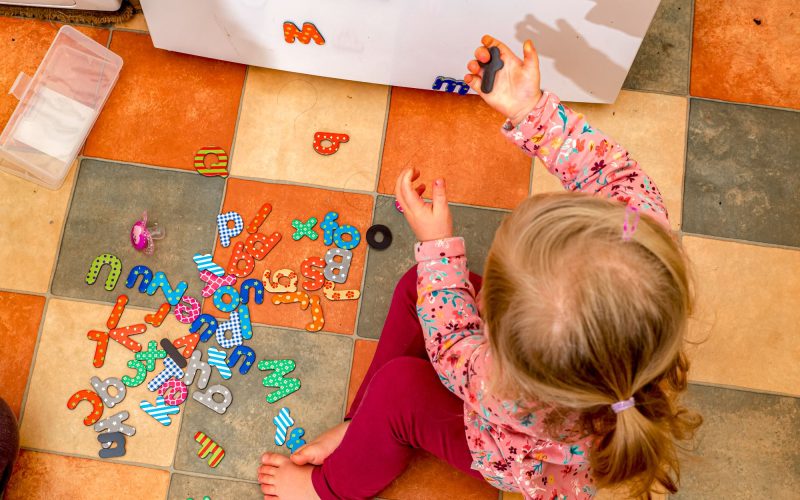Little children learn daily, and toddler learning activities range from merely observing to trying to walk, speak, and understand.
Toddlers continuously take in ideas from their environment and try these out as they explore.
Tender as they are, their minds are pretty active, and they possess a high intellectual capacity that enables them to pick up habits that they see around them.
As a result, it is essential to engage your children in activities that you would want them to learn as they grow.
In this article, we shall discuss some of these activities, their importance, and ways to get your toddler to engage in them.
Learning Activities for Toddlers
Math Activities
There are so many ways to introduce the concept of mathematics to your toddler without worksheets. It is easy to teach them basic counting skills with things you have around the house. Here are some of these activities that you could use as a guide.
- Count the Balls
Counting is a great way to teach your toddler about numbers. Arrange balls in a straight line and count them slowly, starting from one to ten balls. Do this regularly with your toddler.
At first, they’ll have the numbers all mixed up. This is fine as they are just starting to learn. Sooner or later, they can count from one to ten fluently.
- Counting Cars
This is another fun way to teach your child about numbers. Count their toy cars and allow them to count with you.
- How Many?
You can take a step further now that they are learning to count. Ask them simple questions like “How many books are on the table?” or “How many chairs are in the sitting room?” You can ask them to bring you things like, “Can you give me three spoons?”
- Bring me “5”
Give your toddler a purpose. Ask them to get several things. For example, “Bring me six pencils.”
If they bring the correct number of what you requested, applaud them, but correct them if they get an incorrect number.
- Cardboard Numbers
Create large images of numbers with cardboard paper and paste them where they can see them. Read it or ask them to recreate these numbers on a cardboard sheet.
- Playdough Numbers
You can teach your toddler basic arithmetic in the comfort of your kitchen. One way to do so is to make numbers out of dough.
Mix playdough and cut numbers out of them. Say them out loud so that your toddler will imitate you.
- Fill the Cup
Most children love playing with water, so teaching them about volume is relatively easy. You can do this in several ways.
Fill a cup with water and allow them to scoop it into another cup with a spoon.
Better still, let them experiment with their water bottles. Ask, “I wonder how many cups can fill this bottle and watch them experiment with the theory.
- Height Chart
Teach your child about measurement using the height chart. Create one for your child and allow them to make one for their dolls and stuffed animals.
- From the Smallest to the Biggest
Gradually introduce the concept of size by arranging things from the smallest to the biggest and vice versa.
You can do this with balls, blocks, or even kitchen equipment. Ensure that they watch you closely. Afterward, ask them to imitate what you have done.
- The Addition Game
The addition is a little complicated compared to other math activities. To play the addition game, you would need a pair of dice. Show your child how to roll a pair.
Count the number on one face, then count the number on the other. Finally, count them together. Roll the dice again and resume counting.
The Benefits of Math Activities
Teaching math at an early stage is necessary for a child. It develops problem-solving skills and aids decision-making.
Other benefits of math activities include:
- Enhances calculation skills
- Builds confidence
- Nurtures interest in mathematics
- It teaches how to tell time
- Children become more skilled at solving puzzles
- Improves learning
- Teaches the concept of money
- Boosts reasoning
- Enhances analytical thinking
Literacy Activities
Reading and writing are crucial learning processes for a child. The foundation of literacy determines how a child would learn when they start schooling.
For English, your child should have basic knowledge of the alphabet. Understanding this can be fun for your toddler.
Below are some ways to teach the alphabet and new words.
- Reading a Story
Reading to your toddler is a beautiful experience. Not only does it create a strong bond, but it nurtures a love for books. For toddlers, go for simple books that they can understand.
- Picture Books
Images are attractive to minors, making it easier for them to relate to what you are saying.
For example, show them the picture of a ball and say “ball” aloud. This automatically gives them a mental picture of the word “ball.”
- Reciting Rhymes
Reciting rhymes is an exciting way to get your toddler to speak. For easy understanding, go for short rhymes they can repeat repeatedly.
Rhymes like “Twinkle, twinkle, little star,” “Mary has a little lamb,” and “London Bridge” is a great start.
- Singing Songs
Music is one of the toddler learning activities you can’t skip. Aside from rhymes, music is another fantastic way for your toddler to learn. Play songs that you love and sing along. Your toddler would imitate you.
- Coloring Alphabets
Practice coloring and literacy at the same time. Draw out large letters of the alphabet and allow them to color them while reading the letters aloud.
- Sticky Letters
Get sticky letters and place them all over your child’s table. Read each letter to them and allow them to repeat after you. The constant recitation of their letters will make them commit them to memory.
- Alphabet Swat
Your child should love this hilarious activity. The game can be introduced using a bunch of paste-it notes.
Write letters and paste them all over the tabletop, and imagine each letter is a fly.
Now, swat the alphabet! You can try different game versions and slowly move to swat words.
- Scribbling
A toddler can be pretty creative with a pencil and paper. Encourage your child to write the alphabet in order.
They will make many mistakes, but they will surely improve with constant writing. Take it up a notch and teach them to write their names.
- I spy
This word game encourages your child to learn sounds. To play this game, use familiar things like balls, books, crayons, cups, etc.
Recite the words, “I spy with my eye something beginning with c-c-c. What am I looking at?” allow your child to find the object of focus.
- Rhyming Words
Play with words, especially those that rhyme. Encourage your child to do so too. Ask questions like “What other word sounds like a tree?”
The Benefits of Literacy Activities
Early literacy is the building block for language. So, teaching your child from an early age has its benefits.
- Prepares children for teaching and learning
- Develops reading skills
- Develops writing skills
- Broadens knowledge
- Boosts mental health
- Promotes maturity
- Enhances creativity
- Expands vocabulary
Craft
All toddler learning activities must involve crafts. This makes learning fun for them.
Listed below are some thrilling activities your little child can engage in.
- Leaf Print
Printing could get a little messy, but your kid would love this. Gather leaves of various sizes, get watercolors, brushes, and a cardboard sheet (or any surface you want to print on).
Paint a leaf and press it on the cardboard sheet. Take the leaf off, and you have a print on your paper. Make more leaf prints.
- Fingerprint
This is another impressive printing exercise for toddlers. All it requires is different paint colors and a cardboard sheet. Allow your toddler to paint and print their fingers all over the cardboard.
- Shape Collage
This is an excellent way for your child to master shapes. Cut out basic shapes from magazines and old newspapers with scissors and glue them to a large surface to make a collage.
- Paper Plate Sun
This papercraft will brighten up your day, even during rainy days. You will need one yellow paper, several bright colors of sugar paper, a pair of googly eyes, a black pen, red paint scissors, and glue.
Fold each sugar paper into four, draw a triangle in front, and cut out. This will give you equal-sized rays.
Stick your triangles to the back of the paper plate. Turn it over and create a face for your sun.
Use the googly eyes as your own, draw lashes with your black pen, and a smile with your red pen. You can color its cheek red to add a little blush.
- Sock Snowman
This creative craft is great to try out with your child. You would need one white sock, one multi-colored sock, rice, a rubber band, colorful buttons, ribbons, glue gun markers, and orange pom-poms to make it.
Mix your white stocking with rice and tie the top with a rubber band. Place another band in the middle to form a head shape.
Glue the buttons in a straight line to the bottom side. Draw the mouth and eyes with a marker. Use two orange pom-poms to make your nose.
You use the ribbon as a scarf around its neck. Finally, cut the colored sock and roll it to form a cap.
Your snowman is ready!
The Benefits of Craft
- It brings out the creativity in children
- Easy identification of shapes, colors, and texture
- Motor skills are considerably improved
- Children get to learn how to organize
- Kids also get to bond with their parents
- It helps children express themselves
Physical Activities
Early childhood should include physical activity as an essential part of a child’s development.
Below are some activities that could build your toddler physically.
- Stretches
Stretches are a great way to engage your toddler in some physical activity.
Ensure to keep it simple. Stretches like “touch your toes,” “reach to the sky,” and “bend to the side” are examples they can perform without stress.
- Hide and seek
For toddlers, play this game cautiously as they might get frightened by hiding or if they cannot find you.
You can hide in obvious places with an arm or a leg visible to them. You can also make some noises to aid them in finding you.
- Dance
Toddlers are naturally inclined to music and love moving their bodies to the rhythm. Play it and allow them to groove, no matter what song it is. You can also set an example for them by moving to the music.
- Yoga
Get your kid involved if you already do yoga or organized activities like aerobics.
Set out for ten minutes to warm up with them. Add a special sequence of yoga and make it as simple as possible.
- Row, Row, Row Your Boat
“Row your boat” is a great indoor activity for toddlers that requires no equipment.
To perform this exercise, children sit facing their partners, touching their feet.
They hold their hands and lean backward and forward while singing, “Row, row, row your boat, gently down the stream.
Benefits of Physical Activities for Toddlers
Physical activity is essential to a child’s life and contributes positively to them.
Children who engage in physical activity tend to be better at education than those who do not.
Other benefits of these activities include:
- Develops the bones
- Builds strength and endurance
- Develops flexibility
- Improves mental health
- Develops good posture
- Decreases stress
- Enhances social skills
- Builds confidence
- Maintains a healthy weight
- Improves balance
Ways to Encourage Learning in Toddlers
There are so many toddler learning activities that your toddler can engage in.
However, they might not be interested in some of them. Here are some tips that can assist you when trying to encourage your toddler to be active.
- Be Enthusiastic About Learning
Toddlers tend to imitate you. They share your joy and are interested in what you are interested in. If you want them to learn, you need a positive attitude towards learning.
- Use Colors
Toddlers love colorful things. If you want to get their attention, use bright colors for design and craft.
- Keep It Simple
Remember that you are dealing with a toddler. Your child is still tender and does not need anything complicated. Opt for simple activities that they can easily comprehend.
- Make a Game Out of It
To keep your toddler’s interest, make every activity fun for them. Present it as a game to make it look more straightforward and less complicated.
- Give Children an Active Role
Make your child the center of every activity. Try not to focus on lecturing them but allow them to try out new things in their own way.
Investing time into teaching your toddler new activities isn’t only beneficial to you but to your child. So why don’t you try some of the activities listed above?








